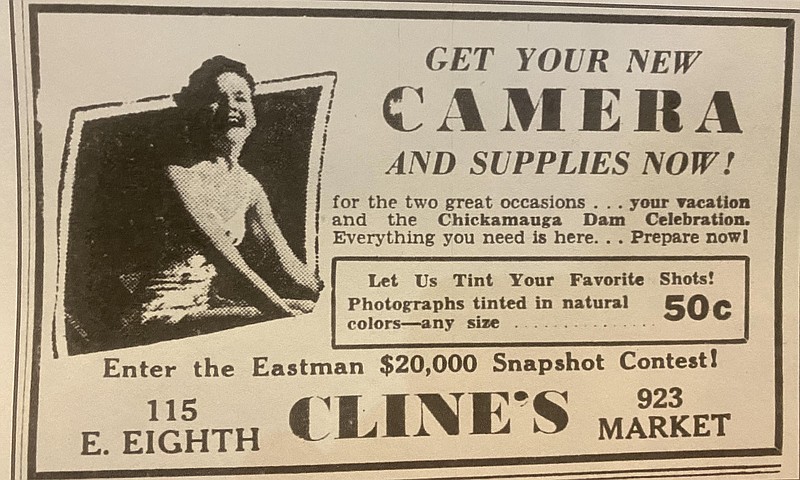Labor Day decorations are being packed away, and area residents are pondering the "Can you wear white after Labor Day?" question. But 81 years ago, the nation's attention was focused on Chattanooga, Tennessee, and the "mighty Chickamauga Dam."
One month earlier, a New York Times headline had proclaimed: "TVA Fete Planned by Chattanooga: 200,000 Visitors from All Over the Nation Expected for Completion of Dam - 10 Lakes to be Dedicated Labor Day Week-End - Will be used to Show the Valley's Industrial Possibilities." If the liberal use of capital letters alone was not enough to mirror the excitement of the planned three-day event, the announcement of President Franklin D. Roosevelt's visit to view the success of the Tennessee Valley Authority's plan for generating electricity, controlling flooding and promoting industrial growth certainly generated national attention.
Planning for the event had begun a year earlier. A Chickamauga Lake and Dam Dedication Committee, chaired by Mark K. Wilson, was announced in a Chattanooga Times article on Feb. 7, 1940. The committee, housed on the second floor of the Chamber of Commerce building, appointed a permanent board of directors for the celebration and officially incorporated the committee and its mission as the Chickamauga Dam Celebration. The charter, drafted by Joe V. Williams Jr. and Frank Darwin, active members of the Chattanooga Bar, provided for board membership to include: Mayor E.D. Bass, Judge Will Cummings, Phil Whitaker, Tom Cuthbert, J.D. Pope, Lee Warren, V.D.L. Robinson, A.H. Sullivan, Emmett S. Newton, D.S. Etheridge, R.L. Moore, W.E. Brock and Wiley Couch. Paul Severance informed the media that Sen. Kenneth McKellar had an appointment with President Roosevelt during which he would personally deliver an invitation.
By May, the excitement was building. J. Charles Poe, Tennessee commissioner of conservation, unveiled a national plan for inviting citizens to "visit the Great Lakes of the South," with a special emphasis on the Chickamauga Dam celebration. The cornerstone of the national campaign was 500 billboards that would be placed on the major highways of the South within a 300-mile radius of Tennessee's borders. The use of four-color billboard printing, relatively new and expensive, was promised, and the commissioner added that billboards also would be placed in Illinois and New York, sites of the other "Great Lakes." Chickamauga Dam Celebration Inc. would fund billboards within the state since Tennessee statutes prohibited the state from advertising within its own borders.
Mark K. Wilson, the first chairman, resigned during the early summer due to increasing work demands. A subcommittee of the board, led by L.J. Wilhoite and Tom Duff, announced that R.E. Biggers, the general manager of Lookout Oil and Refining, had agreed to use his "prominent civic leadership" to champion the celebration. Simultaneously, the board announced that Gov. Prentiss Cooper had offered his aid. In an official statement, the governor heralded Chattanooga's celebration plans as "embracing and commemorating the great Tennessee Valley Authority development program - with its wide possibilities of economic, industrial, recreational and national defense benefits, not only to the states involved but to the nation as a whole. I would be glad to cooperate in any way possible for the success of the celebration."
The Secret Service team, headed by White House Chief Col. Edward W. Sterling, finalized a plan for the president's participation after several visits to possible sites and a thorough study of the events scheduled. It was decided that the south bank of the Chickamauga Lake would be the primary site for the celebration. A 15,000-person grandstand, along the south earth dike, would face the lake where two barges would be anchored for the stage.
Originally planned for Labor Day, the president's visit was delayed due to the increasing tensions related to the war in Europe. Col. Sterling released the notice that the president's train would arrive at about 9:45 a.m. on Sept. 20. Three alternate routes for travel to Chickamauga Lake had been chosen for security reasons. In addition to the president's security force, the Chattanooga Police Department, Hamilton County sheriff and deputies, the Sixth Cavalry stationed at Fort Oglethorpe and members of the Tennessee National Guard would be on duty along the routes. The president's "specially built car" would arrive in Chattanooga on Sept. 14, under the watchful eye of Col. Sterling, who then "made test runs over the route the President would take."
The plans were in place ...
Linda Moss Mines, the Chattanooga-Hamilton County historian, is regent, Chief John Ross Chapter, NSDAR, and chairman of the board of Erlanger Health Systems.
